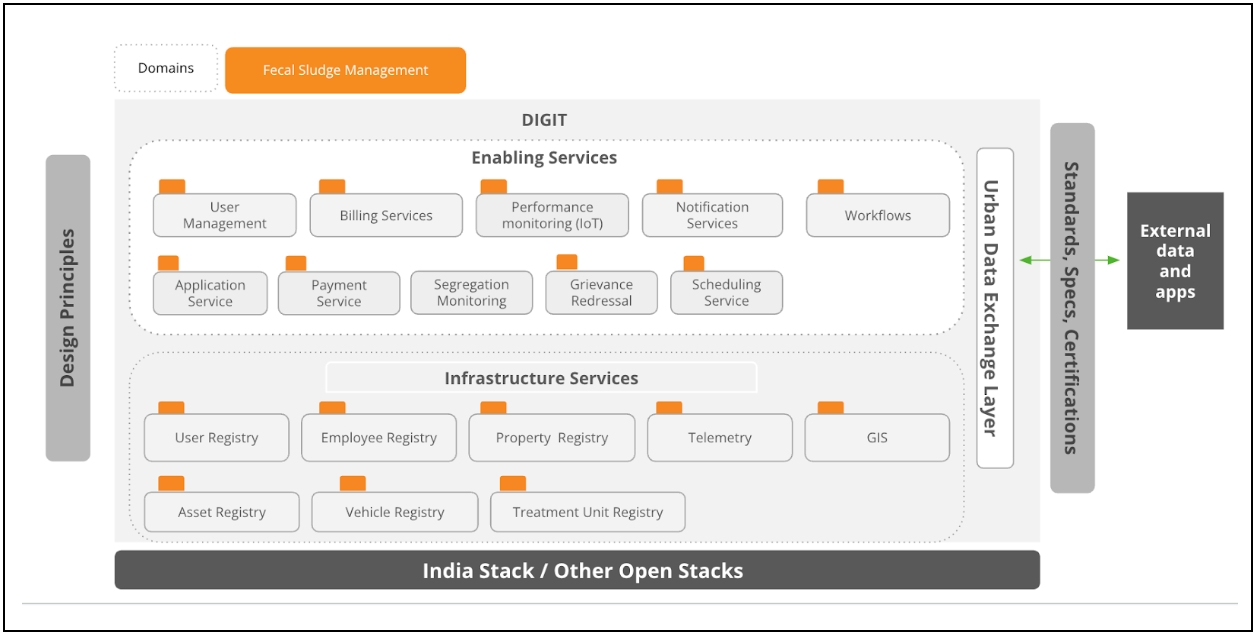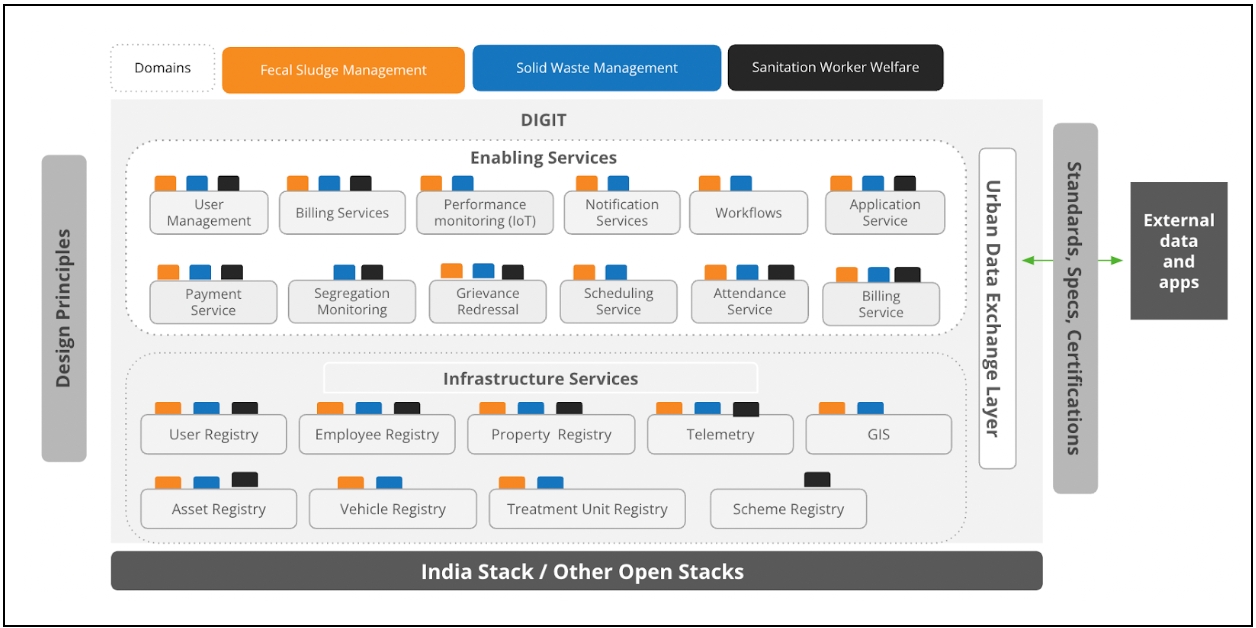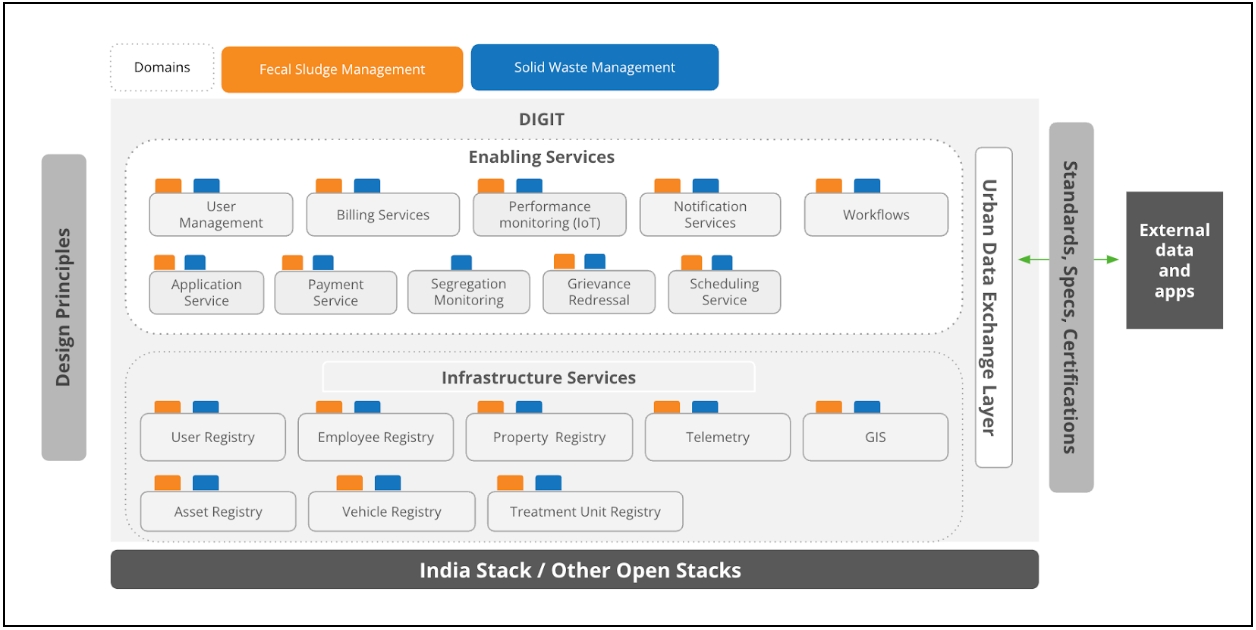
Water-Sanitation is an open-source web and mobile-enabled platform designed to digitise operations in the waste management value chain, from collection to treatment. It provides the ability to drive coordination across multiple independent and disconnected stakeholders, ensuring a continued chain of custody of waste throughout.
According to a United Nations (UN) report, only 54% of the world population has access to safe sanitation. We believe that at the heart of the problems in sanitation are ineffective systems that fail to deliver. Hence, systems must be progressively reformed. To move habitats towards zero untreated waste, we will leverage the capabilities built by the Digital Infrastructure for Governance, Impact & Transformation (DIGIT), and ensure the traceability of waste by enabling the ecosystem with the following features:
Chain of custody: We will ensure a seamless and traceable chain of custody for waste. This will enable stakeholders to track waste from its source to its final destination, ensuring accountability and transparency in the waste management process.
Actionable data: Our system will provide actionable data on waste management operations, which will enable stakeholders to make informed decisions. This data will be used to optimise waste collection and treatment processes, identify areas for improvement, and drive evidence-based decision-making.
Code for innovation: We will foster innovation by providing a digital platform that encourages collaboration among stakeholders. Our system will facilitate the sharing of ideas, best practices, and innovative solutions for sanitation challenges, driving continuous improvement in the waste management ecosystem.
Current digital efforts across geographies do not take a “whole of system view” and do not solve the cost of coordination and duplication issues. Such siloed, solution-centric approaches and tools create a new set of problems and inefficiencies for countries:
Higher costs and time: This is incurred on creating or procuring and maintaining these systems, including the onboarding cost of the same actors in each programme.
Data exists in multiple systems: They are not interoperable, leading to duplication, inconsistencies, poor adoption by on-ground workers, and sub-optimal decision-making.
Limited reusability and innovation: Data and capabilities are intertwined and ‘locked,’ making it extremely hard for the wider ecosystem to innovate and build upon.
Sub-scale: The tools are not able to scale for the national population and across waste streams.
Water-Sanitation solutions are built on the principles of societal platforms, envisioning a space where sanitation is supported by shared resources, curated knowledge, and evolving solutions that address the needs of the community. We recognise that the challenges of sanitation are systemic and require the collective efforts of all stakeholders to be effectively addressed. Drawing from the insights gained from our urban mission, we embrace the triple helix model, which emphasises partnerships among different stakeholders, including civil society (samaaj), government (sarkaar), and industry/market (bazaar), to generate innovation through synergistic collaboration. Leveraging our experience in building large-scale public digital infrastructure, we are well-positioned to create the foundation for this ecosystem and drive progress in solving the most pressing sanitation issues. We believe that by fostering cooperation and collaboration among all stakeholders, we can create sustainable solutions that meet the needs of communities and contribute to the transformation of the sanitation landscape.
While sanitation requirements and solutions may vary among local governments, there are commonalities in the value chain of sanitation waste streams, such as faecal sludge management, solid waste management, plastic waste management, etc. These value chains typically involve steps such as generation, containment, collection, transport, treatment, and disposal/reuse. These similarities provide an opportunity to abstract and digitise various components of the service value chain, with the potential to encode standards and enable data-driven visibility into sanitation services.
The Water-Sanitation solution is specifically designed to allow for the contextualisation and reuse of components across different waste streams and geographies. By incorporating standards into the platform and leveraging data registries and reusable building blocks in the technology stack, applications can be developed more efficiently and quickly at the solution layer, resulting in lower costs and faster implementation. This approach enables flexibility and scalability in addressing diverse sanitation needs, while also promoting interoperability and consistency in the digital solutions deployed. By leveraging the Water-Sanitation solutions, stakeholders can build innovative applications tailored to local contexts, while adhering to standardised components and data structures, leading to more effective and sustainable sanitation services.
Following is a glimpse of how this would work:
The above image illustrates the core infrastructure services, and the enabling services that are built/configured for a Faecal Sludge Management (FSM) solution with the following functionality:
Allowing citizens to request septic tank desludging services
Scheduling desludging services for a certain set of property types/localities, etc.
Automated or manual assignment of vendors to perform requests
Tracking sludge from collection to disposal at a treatment plant using the Internet of Things (IoT)
Notifications to stakeholders at each point in the workflow
Dashboards and reports
Now, consider that instead of FSM, a solution needs to be built for Solid Waste Management:
The same set of infrastructure and enabling services could be used to configure the following functionalities:
Scheduling the collection of waste based on different categories
Automated or manual assignment of vendors to perform requests
Tracking adherence to the schedule
Tracking waste movement from pickup to disposal at a treatment facility
Notifications to stakeholders at each point in the workflow
Dashboards and reports
Further, only an additional service for segregation monitoring would have to be built.
To illustrate this further, imagine building a solution for sanitation worker welfare:
The same set of services can be used here as well, with the addition of a few components. The Water-Sanitation platform is built leveraging the DIGIT Core Services, which are customised into the following key building blocks:
Service Request Management
Define pricing
Record service requests
Assign and manage service requests
Provide subsidies
Calculate service fees
Track status
Collect feedback
Transport Management
Schedule pickup
Assign vehicles and drivers
Track status
Billing and Payments
Generate demand
Generate receipts
Online payment gateway
Notifications
SMS
In app
Service Delivery Monitoring
Dashboards
Reports


